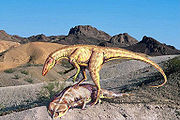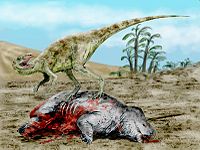
Staurikosaurus
Encyclopedia
Staurikosaurus is a genus
of herrerasaurid
dinosaur
from the Late Triassic
of Brazil
.
 The first known specimen of Staurikosaurus was recovered from the Paleontological Site Jazigo Cinco
The first known specimen of Staurikosaurus was recovered from the Paleontological Site Jazigo Cinco
of the Santa Maria Formation
in the geopark
of paleorrota
, Rio Grande do Sul
, southern Brazil
. The genus name refers to the star
constellation
"The Southern Cross", pictured in the coat of arms of Brazil
and only visible in the southern hemisphere
- when Staurikosaurus was described in 1970, it was unusual to find dinosaurs in the southern hemisphere. The specific name honours the Brazilian paleontologist Llewellyn Ivor Price
, who discovered it in 1936. It was described by Edwin Harris Colbert
, working at the American Museum of Natural History
. The rarity of Staurikosaurus remains may be a result of it being uncommon while alive, or because it lived in an environment like a forest, where fossils rarely form.

 Staurikosaurus was a small theropod from the late Triassic
Staurikosaurus was a small theropod from the late Triassic
Period, 225 million years ago - specifically the Carnian
age. It is one of the earliest dinosaurs that is known. At just 2.25 metres (7.4 ft), 80 centimetres tall (31 in), and weighing just 30 kilogram
s (66 lb
), Staurikosaurus was tiny in comparison to later theropods like Megalosaurus
. Newer research seems to confirm that Staurikosaurus and the related Herrerasaurus
are definite theropods and evolved after the sauropod line had split from the Theropoda.
There exists very incomplete fossil record of Staurikosaurus, consisting most of the spine, the legs and the large lower jaw. However, dating from such an early period in the dinosaurs' history and being otherwise so primitive, most of Staurikosaurus other features as being primitive also can be reconstructed. For example, Staurikosaurus is usually depicted with five toes and five fingers - very simple features of an unspecialised dinosaur. However, since the skeletal structure of the legs is known, it can be seen that Staurikosaurus was a quick runner for its size. It also had just two vertebrae joining the pelvis
to the spine
, a distinctly primitive arrangement.
Contemporaries
Genus
In biology, a genus is a low-level taxonomic rank used in the biological classification of living and fossil organisms, which is an example of definition by genus and differentia...
of herrerasaurid
Herrerasauridae
Herrerasaurids are among the oldest known dinosaurs, appearing in the fossil record 231.4 million years ago . They became extinct by the end of the Triassic period. Herrerasaurids were small-sized carnivorous theropods or basal saurischians...
dinosaur
Dinosaur
Dinosaurs are a diverse group of animals of the clade and superorder Dinosauria. They were the dominant terrestrial vertebrates for over 160 million years, from the late Triassic period until the end of the Cretaceous , when the Cretaceous–Paleogene extinction event led to the extinction of...
from the Late Triassic
Late Triassic
The Late Triassic is in the geologic timescale the third and final of three epochs of the Triassic period. The corresponding series is known as the Upper Triassic. In the past it was sometimes called the Keuper, after a German lithostratigraphic group that has a roughly corresponding age...
of Brazil
Brazil
Brazil , officially the Federative Republic of Brazil , is the largest country in South America. It is the world's fifth largest country, both by geographical area and by population with over 192 million people...
.
Discovery

Paleontological Site Jazigo Cinco
Paleontological Site Jazigo Cinco is located in the city of Santa Maria, Rio Grande do Sul, Brazil. And belongs to Santa Maria Formation. It is located in the neighborhood Kilometro 3 near Castelinho, is to 2.7 kilometers away from the Paleontological Site Arroio Cancela. It belongs to UFSM and is...
of the Santa Maria Formation
Santa Maria Formation
The Santa Maria Formation is a sedimentary rock formation found in Rio Grande do Sul, Brazil. It has a late Ladinian – early Carnian age , and is notable for its fossils of early dinosaurs, including the herrerasaur Staurikosaurus, the basal saurischian Teyuwasu, and the basal sauropodomorph...
in the geopark
Geopark
A Geopark is defined by the United Nations Educational, Scientific and Cultural Organization in its UNESCO Geoparks International Network of Geoparks programme as follows:...
of paleorrota
Paleorrota
Paleorrota , is a geopark located in the center of the Brazilian state of Rio Grande do Sul. The rocks and fossils found along the route date back to the times when there was only one supercontinent Pangaea....
, Rio Grande do Sul
Rio Grande do Sul
Rio Grande do Sul is the southernmost state in Brazil, and the state with the fifth highest Human Development Index in the country. In this state is located the southernmost city in the country, Chuí, on the border with Uruguay. In the region of Bento Gonçalves and Caxias do Sul, the largest wine...
, southern Brazil
Brazil
Brazil , officially the Federative Republic of Brazil , is the largest country in South America. It is the world's fifth largest country, both by geographical area and by population with over 192 million people...
. The genus name refers to the star
Star
A star is a massive, luminous sphere of plasma held together by gravity. At the end of its lifetime, a star can also contain a proportion of degenerate matter. The nearest star to Earth is the Sun, which is the source of most of the energy on Earth...
constellation
Constellation
In modern astronomy, a constellation is an internationally defined area of the celestial sphere. These areas are grouped around asterisms, patterns formed by prominent stars within apparent proximity to one another on Earth's night sky....
"The Southern Cross", pictured in the coat of arms of Brazil
Coat of arms of Brazil
The coat of arms of Brazil was created on November 19, 1889, four days after Brazil became a republic.The coat of arms consists of the central emblem surrounded by coffee and tobacco branches, which were important crops in Brazil at that time.In the blue circle in the center, the Southern Cross ...
and only visible in the southern hemisphere
Southern Hemisphere
The Southern Hemisphere is the part of Earth that lies south of the equator. The word hemisphere literally means 'half ball' or "half sphere"...
- when Staurikosaurus was described in 1970, it was unusual to find dinosaurs in the southern hemisphere. The specific name honours the Brazilian paleontologist Llewellyn Ivor Price
Llewellyn Ivor Price
Llewellyn Ivor Price was one of the first Brazilian paleontologists.-Biography:Price's work contributed not only to the development of Brazilian but also to global paleontology...
, who discovered it in 1936. It was described by Edwin Harris Colbert
Edwin Harris Colbert
Edwin Harris Colbert was a distinguished American vertebrate paleontologist and prolific researcher and author. He received his A.B. from the University of Nebraska, then his Masters and Ph.D. from Columbia University, finishing in 1935.Born in Clarinda, Iowa, he grew up in Maryville, Missouri...
, working at the American Museum of Natural History
American Museum of Natural History
The American Museum of Natural History , located on the Upper West Side of Manhattan in New York City, United States, is one of the largest and most celebrated museums in the world...
. The rarity of Staurikosaurus remains may be a result of it being uncommon while alive, or because it lived in an environment like a forest, where fossils rarely form.
Description


Triassic
The Triassic is a geologic period and system that extends from about 250 to 200 Mya . As the first period of the Mesozoic Era, the Triassic follows the Permian and is followed by the Jurassic. Both the start and end of the Triassic are marked by major extinction events...
Period, 225 million years ago - specifically the Carnian
Carnian
The Carnian is the lowermost stage of the Upper Triassic series . It lasted from about 228.7 till 216.5 million years ago . The Carnian is preceded by the Ladinian and is followed by the Norian...
age. It is one of the earliest dinosaurs that is known. At just 2.25 metres (7.4 ft), 80 centimetres tall (31 in), and weighing just 30 kilogram
Kilogram
The kilogram or kilogramme , also known as the kilo, is the base unit of mass in the International System of Units and is defined as being equal to the mass of the International Prototype Kilogram , which is almost exactly equal to the mass of one liter of water...
s (66 lb
Pound (mass)
The pound or pound-mass is a unit of mass used in the Imperial, United States customary and other systems of measurement...
), Staurikosaurus was tiny in comparison to later theropods like Megalosaurus
Megalosaurus
Megalosaurus is a genus of large meat-eating theropod dinosaurs of the Middle Jurassic period of Europe...
. Newer research seems to confirm that Staurikosaurus and the related Herrerasaurus
Herrerasaurus
Herrerasaurus was one of the earliest dinosaurs. All known specimens of this carnivore have been discovered in rocks of late Ladinian age in northwestern Argentina...
are definite theropods and evolved after the sauropod line had split from the Theropoda.
There exists very incomplete fossil record of Staurikosaurus, consisting most of the spine, the legs and the large lower jaw. However, dating from such an early period in the dinosaurs' history and being otherwise so primitive, most of Staurikosaurus other features as being primitive also can be reconstructed. For example, Staurikosaurus is usually depicted with five toes and five fingers - very simple features of an unspecialised dinosaur. However, since the skeletal structure of the legs is known, it can be seen that Staurikosaurus was a quick runner for its size. It also had just two vertebrae joining the pelvis
Pelvis
In human anatomy, the pelvis is the lower part of the trunk, between the abdomen and the lower limbs .The pelvis includes several structures:...
to the spine
Vertebral column
In human anatomy, the vertebral column is a column usually consisting of 24 articulating vertebrae, and 9 fused vertebrae in the sacrum and the coccyx. It is situated in the dorsal aspect of the torso, separated by intervertebral discs...
, a distinctly primitive arrangement.
See also
- PaleorrotaPaleorrotaPaleorrota , is a geopark located in the center of the Brazilian state of Rio Grande do Sul. The rocks and fossils found along the route date back to the times when there was only one supercontinent Pangaea....
Contemporaries
- AetosaurAetosaurAetosaurs are an extinct order of heavily armoured, medium- to large-sized Late Triassic herbivorous archosaurs. They have small heads, upturned snouts, erect limbs, and a body covered by plate-like scutes. All aetosaurs belong to the family Stagonolepididae...
s - RauisuchiaRauisuchiaRauisuchia is a group of predatory and mostly large Triassic archosaurs. As a clade, Rauisuchia includes these Triassic forms and all crocodylomorphs, which are descendants of Triassic rauisuchians. The group in its traditional sense is paraphyletic, because it does not include crocodylomorph...
ns

